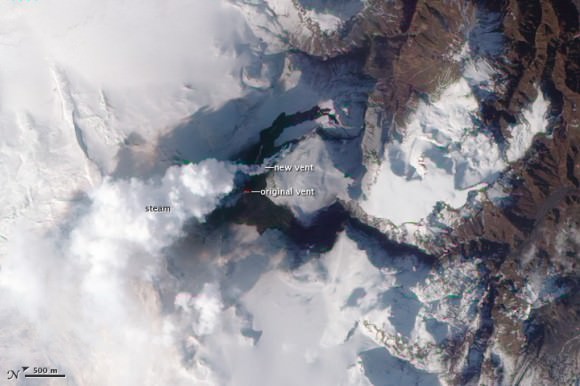[/caption]
Night-shining “noctilucent” clouds create a magical glow in the night skies over Reykjavíc, Iceland in this beautiful photo by Örvar Atli Þorgeirsson, taken on August 6. In the foreground is “The Sun Voyager” (Sólfar), an iconic steel sculpture located on the city waterfront representing a Viking ship.
Örvar did not set out to photograph this rare atmospheric phenomenon but had instead intended to shoot aurora triggered by recent solar outbursts.
“The forecast on the 6th of August was predicting extreme aurora activity,” Örvar says in his Flickr description. “Even though it was very early August and the night would not get fully dark I went out as the aurora can be seen in deep twilight conditions. I saw the aurora for 1 – 2 minutes that night. I did not get a good picture of it though. Instead we witnessed this even rarer phenomenon called noctilucent clouds.”
Noctilucent clouds are extremely high-level clouds made located in the mesosphere, around 76 to 85 kilometers (47 to 53 miles) high… nearly at the very edge of space. (Most commercial airplanes fly between 6 and 7 miles high.) They are high enough to reflect sunlight coming from beyond the horizon long after night has fallen over the land below. They usually appear as a wispy web of blue, white, purple and orange tendrils stretched across the sky.
“These clouds where extremely beautiful to look at and reminded me of the aurora but where much more stationary and had this beautiful blue color.”
– Örvar Atli Þorgeirsson
Noctilucent clouds are mainly visible at latitudes between 50º – 70º north and south during the months of June and July. This means Reykjavíc, located right in the middle, can get great views. (Of course it helps to have a talented photographer like Örvar to capture them so nicely!)
Oddly enough noctilucent clouds are a relatively recent phenomenon, only having been recorded for about 120 years. They have been connected with space shuttle passages through the upper atmosphere, and it’s even been suggested that they may be associated with the 1908 Tunguska impact.
Read more about noctilucent clouds here.
Image © Örvar Atli Þorgeirsson. All rights reserved. Used with permission.
_____________________
Jason Major is a graphic designer, photo enthusiast and space blogger. Visit his website Lights in the Dark and follow him on Twitter @JPMajor or on Facebook for the most up-to-date astronomy news and images!



